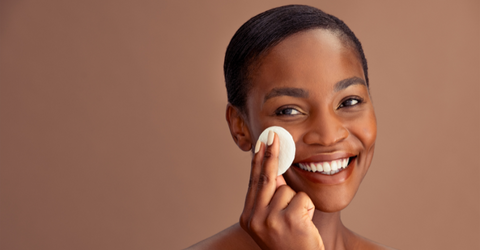Welcome, skincare enthusiasts! Today, we embark on a journey to unravel one of the fundamental aspects of skincare: understanding your skin type. Whether you're a skincare novice or a seasoned pro, knowing your skin type lays the foundation for an effective skincare routine tailored to your unique needs.
In the vast universe of skincare, one size does not fit all. Your skin is as unique as your fingerprint, and understanding its quirks is the first step towards achieving that enviable glow.
Everyone has a unique skin with unique care and what works for others might not work for you and vice versa. Today knowing what ingredients skincare products contain and how those ingredients will react on their skin is tricky. Therefore, before using any product identifying your skin type will help to prevent your skin from harmful reactions and side effects.
But fear not, dear reader! Here is a guide to help you identify your skin type so that you can choose the best products for your skin type. Our goal is to arm you with the needed knowledge to curate a skincare regimen tailored to your skin's needs.
Let’s embark on this enlightening journey together and explore the best ways to know your skin type.
Why Identifying Your Skin Type Matters
Before we delve into the nitty-gritty of skin typing, let's take a moment to understand why it's crucial. Your skin type dictates the kind of skincare you should use, how often you should use them, and even the lifestyle choices that can impact your skin's health. Essentially, it's the compass guiding you through the vast world of skincare.
How Many Skin Types Are There?
Skin, much like life, comes in a delightful array of variations. Here's a rundown of the main skin types you might encounter along your skincare expedition.
In the realm of skincare, we generally categorize skin into four main types: normal, oily, dry, and combination. Here's a brief overview of each:
Normal Skin - Balanced, neither too oily nor too dry. It feels comfortable with minimal sensitivity and few visible pores.
Oily Skin - Produces excess sebum, leading to a shiny complexion, enlarged pores, and a propensity for acne and blemishes. Yet, still need hydration.
Dry Skin - Lacks moisture, often feeling tight, rough, or flaky. It's prone to fine lines, redness, and irritation.
Combination Skin - A blend of oily and dry areas, usually with an oily T-zone (forehead, nose, and chin) and drier cheeks.
How to Identify Your Skin Type?
The question you are all wondering “Under which category your skin type falls?” and how to recognize it.
Normal Skin Type - Characteristics: no sensitivity, very small or no visible pores and a healthy, radiant complexion.
Sensitive Skin Type - Characteristics: Prone to redness, itching, burning, and dryness, often reacting to external stimuli with discomfort.
Oily Skin Type - Characteristics: Hello, shine! Enlarged pores, blackheads, whiteheads, pimples, dull, shiny and an overall greasy appearance take centre stage.
Dry Skin Type - Characteristics: Struggling with pores, red patches, skin cracking or peeling, lack of elasticity, and an overall tight, parched and dry sensation.
Combination Skin Type - Characteristics: A mixed bag of larger pores, blackheads, whiteheads, and occasional shine, typically concentrated in the T-zone.
Acne Skin Type - Characteristics: The battleground of small red bumps, pimples, tender bumps, and pus-filled lumps, often exacerbated by excess oil production.
How to Test Your Skin Type
Now, onto the fun part – determining your skin type! Here's a simple guide:
The Bare-Faced Test - Begin with a freshly cleansed face, ensuring there's no makeup or skincare products on your skin. Let your skin breathe for about an hour.
Observation Time - Take a good look at your skin in a well-lit area. Pay attention to its texture, shine, and any visible signs of dryness or oiliness.
Blotting Paper Experiment - Gently dab a blotting paper on different areas of your face – forehead, nose, cheeks, and chin. Observe any oiliness transferred onto the blotting paper.
Hydration Check - After observing for an hour, take note of how your skin feels. Does it feel comfortable and balanced, or does it feel tight and parched?
Sensitive Skin Evaluation - Lastly, assess your skin's sensitivity by recalling any reactions to skincare products or environmental factors.
Test For Skin Type In Depth
Now that we've familiarise ourselves with the skin types, let's dive into the detective work of identifying your skin's unique persona:
- Watch and Wait
The first method is very simple and easy as it is an observation method.
How to perform this test?
- Step 1: Wash and cleanse your face with a gentle cleanser and wait for 30 minutes to see how your skin behaves.
- Step 2: Tightness? Hello, dry skin. Shine? Oily skin. Shine limited to the T-zone? Welcome to the world of combination skin. Redness or burning? Sensitive skin. Hydrated and comfortable? Normal skin. Pimples and dark spots? Acne, we meet again. Usually, oily skin leads to acne.
- Dab tissue test
Dab a tissue on your face to find your forehead and cheeks and see if you notice any oil or wetness on the tissue. If this is the case then you have oily skin.
- Step 1: Gently dab a tissue on your face across your forehead and cheeks to detect any oil, wetness or moisture. If this is the case then you have oily skin.
- Step 2: Move on to the T-zone area, encompassing the nose and lips, and repeat the process.
- Step 3: See the results on the tissue. Oil on the T-zone? Congratulations, you have a combination of oily and dry skin.
Decoding the Results
Once you've completed these steps, it's time to decode your skin type:
Normal Skin - If your skin feels comfortable with minimal oiliness or dryness and doesn't show signs of sensitivity, congratulations – you likely have normal skin!
Oily Skin - If your skin appears shiny, especially on the T-zone, and the blotting paper reveals significant oiliness, you're likely dealing with oily skin.
Dry Skin - If your skin feels tight, looks flaky, and shows minimal oiliness on the blotting paper, it's a tell-tale sign of dry skin.
Combination Skin - If you notice oiliness in the T-zone but dryness on the cheeks, you probably have combination skin.
Discovering your skin type is the first step towards crafting a skincare routine that caters to your skin's unique needs. Remember, skincare is a journey, not a destination. Embrace your skin type, and let it guide you towards a radiant complexion.
Your Skin Type Decoded
Armed with the knowledge of your skin type, you're now equipped to create an effective skincare routine for you that caters to its unique needs.
One last tip, before you apply any product on your skin, identify your skin type and read the ingredients the product contains. Do your initial research whether the ingredients present in the product are right for you. When in doubt, consult a dermatologist, especially if your skin leans towards the sensitive side.
Until next time, happy skincare adventures!





Comments (0)
There are no comments for this article. Be the first one to leave a message!